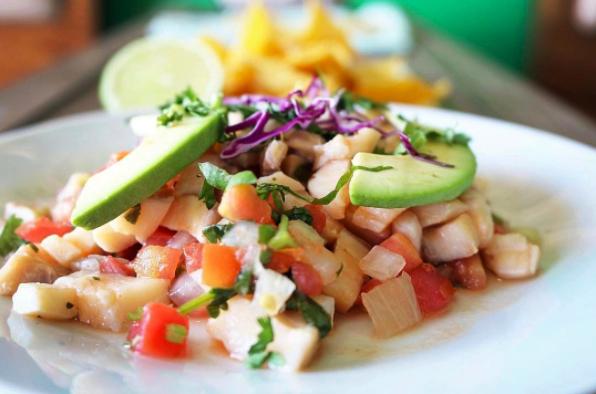This Worldwide Guide To Ceviche Will Stir Your Cravings

@salsaverdemexrest
Nothing declares springtime like a reminder that ceviche is back. After a long chilly winter, we can see a light at the end of the tunnel that looks a lot like a bowl of citrus-spiked seafood on the beach. Ceviche is a South American-rooted dish typically made from chunks of fresh raw fish cured in lemon or lime juice and spiced with chili peppers and other ingredients. Curing the fish means it isn’t raw but it isn’t quite cooked either. After a few minutes in a citrus bath, the citric acid will make the fish seem firm and opaque on the outside, while the inside remains raw and sashimi-like. Chefs also incorporate ingredients like chopped onions, cilantro and other vegetables for a pop of color and flavor contrast. Ceviche originated in Peru and made its way around the globe, becoming an important part of so many diverse cuisines. This worldwide guide to ceviche will stir all of your seafood cravings.
Peru
June 28 is National Ceviche Day in Peru. Modern Peruvian ceviche is made with chunks of raw fish — traditionally shark, sole or sea bass — that’s marinated in lemon, lime or bitter orange juice. It’s tossed with ingredients like chili, sliced onions, salt, pepper, garlic and olive oil for a few minutes and served at room temperature shortly after. It’s usually served with corn-on-the-cob and pieces of sweet potato.
Panama
Every country has its own take on ceviche. In Panama, cilantro is a core ingredient and local fish is used, like white sea bass and seafood like shrimp, squid or octopus, as the base. The fish is mixed with onion, celery, sea salt, assorted peppers and lemon juice. You might also see Panama-style ceviche served in little pastry shells called canastitas.
Ecuador
Over in Ecuador, thinly sliced plantain chips, popcorn and toasted corn kernels are served alongside ceviche. Shrimp ceviche is often made with tomato sauce, giving it a refreshing tangy flavor. There’s also Manabí-style ceviche made with lime juice, salt and the juice of the cooked shrimp. It’s common for Ecuadorians to use local shellfish like black clam, crab, oysters and barnacles.
Cuba
Mahi-mahi, shrimp, scallops, squid and tuna are commonly used for ceviche in Cuba. The fish is marinated with lime juice, salt, onion, green pepper, habanero pepper and allspice for a little kick. Since it’s an Island, their options for fresh seafood are pretty abundant. Lucky for us, we can travel to Cuba now and try their ceviche first hand.
Chile
Chilean ceviche is made from halibut or Patagonian toothfish, a species of cod icefish found in cold waters. The fish is marinated in grapefruit and lime juices and then married with minced garlic, lemon juice, onion, red chili peppers, fresh mint, cilantro, sea salt and black pepper.
Costa Rica
Costa Rica and Nicaragua have similar styles when it comes to ceviche. The dish usually comes in a cocktail glass with a lettuce leaf and often soda crackers on the side. They marinate fish like tilapia, mahi-mahi, shark, marlin and corvina (a fish with a white and flaky texture and mild, sweet taste) in lime juice with salt, ground black pepper, finely chopped onions, coriander and finely minced peppers. The ceviche is eaten with condiments like ketchup and Tabasco sauce.
Philippines
Filipino-style ceviche uses a cooking process that’s a little different from the traditional citrus-curing in Latin American ceviches. Kinilaw, an indigenous cooking process that’s used for all sorts of dishes, uses coconut vinegar and other acidic fruit juices to cure. Fish like Tanigue (Spanish mackerels), marlin, swordfish and anchovies are cubed and marinated in the coconut vinegar and then combined with salt, black pepper, ginger, onions and chili peppers. Ceviches in the Philippines are diverse with ingredients like squid, clams, oysters, crabs, sea urchin, roe, seaweed, vegetables and sometimes cooked meats.
Brazil
Now more than ever, ceviche is a hit in Brazil because of an influx of Peruvian cuisine. Brazilians like to go the fruity route with their ceviche, so they use plenty of pineapple, mango and starfruit. Sea bass is pretty popular for Brazilian-style ceviche, but easy access to the coastline allows for tremendous options when it comes to the fish and seafood used for this popular dish.
Mexico
If you’re getting real authentic-style Mexican ceviche, even though the dish isn’t native to Mexico, you can expect it in cocktail cups, atop tostadas or used as a taco filling and garnished with hot sauce. Ingredients include mahi-mahi, sea bass, red snapper, scallops and shrimp, along with tomatillos, avocados, olives, cucumbers, salsa and cilantro.











